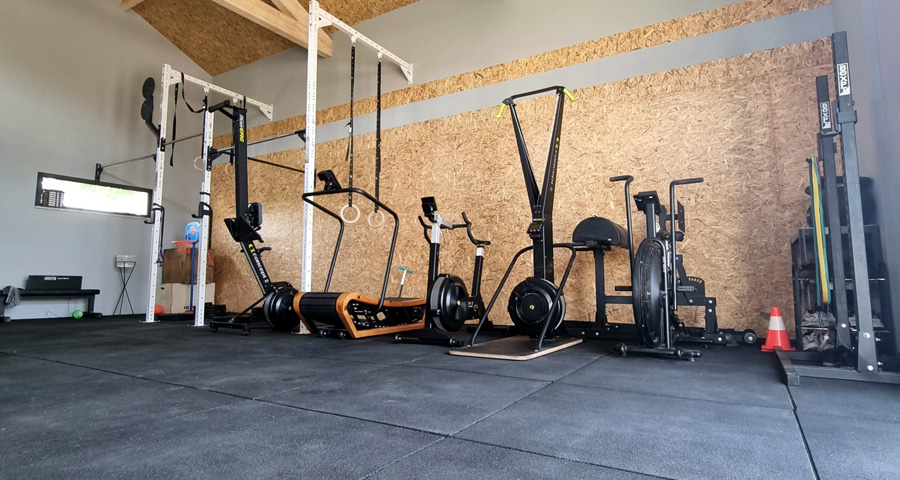Setting up a home gym is a complex process. Multiple factors must be considered before filling your garage or spare room with equipment. So, start by mapping out the space, establishing goals and talking to people who have already set up their home gym. Tapping into other folks’ experience is a superb way to gather important intel.
We picked the brains of those who’ve already set up their own space or have been through a similar process. We talked to gym owners Renato Mendes – Flex Fit Studio (Portugal), Javier Rubiales – Fitsios (Spain) and Hugo Duruel – Hybrid Coaching 76 (France), as well as athletes Pedro Matos (Portugal), Jaime Rodriguez (Espanha) and Bruno Brousmiche (França), who all have a gym at home.
GeometrikTarget: Which factors are the most important when setting up a home gym?
Hugo Duruel: The main thing to consider is the space available. Then the material you’re going to use and install.
Renato Mendes: In my opinion, the key factor is the material/equipment we install. Don’t forget that we’ll be working with tension and load, things that cause great wear and tear. If the material is substandard, it’ll need replacing soon.
Make sure you have a space suitable for training and 100% designed for exercise. With the right customisations, a gym can be set up in a bedroom, the living room, or the garage.
Ventilating the space is also important, particularly for small areas. Choose a room with windows or doors that bring in outside air, so the room can be ventilated. If this isn’t possible, think about installing an A/C unit or fans. This will make breathing easier and will be less demanding physically.
Before buying equipment, ensure the space doesn’t need any work, e.g. electrical installations, changes to the plumbing, or floor levelling. This area must be prepared to absorb impact and noise, so you don’t upset the neighbours and don’t damage the structure.
GT: What should be prioritised during this process?
Javier Rubiales: I think the priority was to get hold of the key materials to work with. These had to be top quality, given the exercise mechanics. There’s a big difference in terms of quality out there.
Pedro Matos: People have different priorities depending on their goals. That said, I’d say start your investment by buying equipment to perform the workouts/movements that you enjoy and know well. Training alone isn’t fun nor easy, so choose equipment you enjoy using and workouts you enjoy doing, that you’re familiar with. These are the top priorities to start with. Everything else will develop naturally.
Also, set a budget and an amount for each stage (works, equipment, flooring, decoration, etc.). Study all your options before going out and purchasing materials. Set priorities. This reduces the likelihood of spending money on less important things and going over budget.
GT: What problems might you encounter and how can you overcome them?
Jaime Rodriguez: The main issue is the cost of the initial investment and potential limitations with the space. My main piece of advice for every situation is to only buy the equipment strictly necessary to perform your training routine.
I always point out that my first gym had a bar for lifting, two chairs and rubber bands, because that’s all I needed for my workout. As things progressed, I bought more equipment. Until today.
The best equipment is what meets your goals, not what influencers are recommending.
Off topic, the main problem is potential vibrations from training with a bar in a flat. The best solution is to control how the bar hits the ground, installing the right protective flooring, and using bumpers where possible.
Bruno Brousmiche: Noise and vibrations, using tailored equipment and flooring.
Flooring is key to ensure comfort and safety when working out. This helps to protect the foundations, equipment and the athlete. It also lessens impacts and vibrations, meaning you don’t upset the family/neighbours when working out.
Rubber flooring is the most appropriate choice for muscle-building workouts and when using heavy loads and equipment. It also offers the versatility to perform different exercises and disciplines. Choose padded flooring, such as Tatami, for combat exercises and more holistic activities such as yoga.
GT: How to get the most out of your space?
Hugo Duruel: Before getting to work, I recommend planning things on paper, visualising the space, and considering the material adjusted to the room.
Jaime Rodriguez: By choosing the most versatile accessories possible. A weights rack can be the best space (and money) saver in a home gym because it allows us to include multiple accessories a single structure: lifting bar, Olympic bar holders, dips station, landmine, pulley machines, etc.
But again, the best way to maximise space is to not fill it with stuff you don’t need.
Storage is essential to free up space. Consider making or buying shelves for storing small items like rubber bands, rope, mats or rolls. A well-organised wall can be a great way to store smaller items without taking up too much floor space.
You can create the feeling of a larger space by installing mirrors on the wall. This doesn’t only add a touch of decoration to your home gym; you can use them to watch the exercises you’re doing.
Use natural light when possible. Combining it with white walls and mirrors will create a more spacious environment.
Pedro Matos, an athlete, has his own space that he calls the Humble Box. So we asked him: What advice would you like to have received before setting up a home gym?
“Honestly, looking back, I don’t think I missed much. Perhaps because I was so sure I wanted to have my gym, and so focused on that. I only focused on solutions to attain my goal. So it’s difficult to offer any advice other than this: clearly establish why you want a home gym and all your decisions will come naturally.”
Establish a training routine you like and feel comfortable with. This is a very important decision, as it affects your budget, the equipment, flooring and atmosphere in your gym.
Create a space where you feel comfortable and motivated when training. Decorate the walls with pictures, phrases and even mirrors. But be careful not to install anything that might fall off or impair training performance.
Be patient when choosing materials and assess your options carefully. This will lower the probability of making a decision you regret.
Setting up your own home gym can be extremely rewarding. Remember the benefits it will bring to your daily life and health. Invest in a space you’re really happy with and provides daily motivation to train harder.

